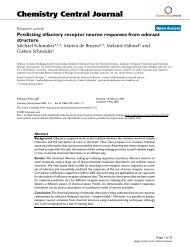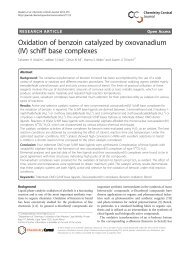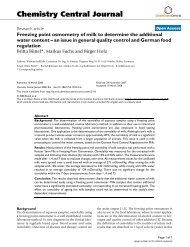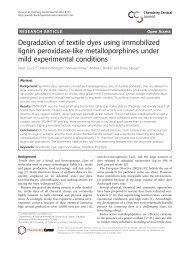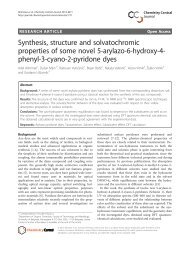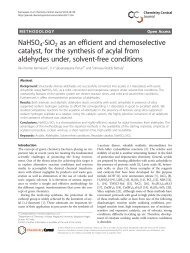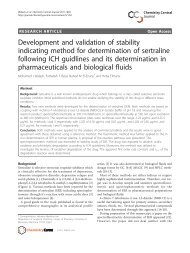Quinazoline derivatives: synthesis and bioactivities - Chemistry ...
Quinazoline derivatives: synthesis and bioactivities - Chemistry ...
Quinazoline derivatives: synthesis and bioactivities - Chemistry ...
Create successful ePaper yourself
Turn your PDF publications into a flip-book with our unique Google optimized e-Paper software.
Wang <strong>and</strong> Gao <strong>Chemistry</strong> Central Journal 2013, 7:95 Page 3 of 15<br />
http://journal.chemistrycentral.com/content/7/1/95<br />
R 1<br />
O O P Rf<br />
O O<br />
O<br />
3<br />
R<br />
N R 3<br />
N R 2<br />
12<br />
3<br />
N<br />
R 2 R 2 O P Rf +<br />
N 3 Rf = CH 2 CH 2 C 8 F 17<br />
N<br />
3<br />
N R 3<br />
R 1 P R (Ph-Rf)3 1<br />
11 13 14 15<br />
Scheme 4 Synthesis of 3H-quinazolin-4-ones via aza-Wittig reaction.<br />
minutes. Thus, when applied in fields of organic <strong>synthesis</strong>,<br />
pharmaceutical chemistry <strong>and</strong> high-throughput<br />
chemistry, microwave heating shows greater advantage<br />
than traditional heating methods [28-31].<br />
Luo et al. reported the first microwave-assisted<br />
<strong>synthesis</strong> of new quinazoline derivates containing α-<br />
aminophosphonate [32]. In their method, N’-(substituted-<br />
2-cyanophenyl)-N,N-dimethyl-formamidine <strong>derivatives</strong> <strong>and</strong><br />
dialkyl amino (phenyl) were adopted as the raw materials<br />
to react in 4:1 volume ratio of isopropanol to acetic acid<br />
solvent for 20 min under microwave irradiation (100°C,<br />
100 psi), <strong>and</strong> obtained twenty-four quinazoline compounds<br />
18, two of which had similar activity as commercial reagent<br />
Ningnanmycin (Scheme 5).<br />
Tu et al. reported a fast, one-pot, microwave-assisted <strong>synthesis</strong><br />
of polysubstituent imidazo[1,2-a]quinoline, pyrimido<br />
[1,2-a]quinoline <strong>and</strong> quinolino[1,2-a]quinazoline <strong>derivatives</strong><br />
[33]. They explored the optimal reagent, volume <strong>and</strong><br />
heating temperature by testing different reagents under<br />
different reaction time <strong>and</strong> temperature. Then under the<br />
optimal conditions (2.0 mL glycol <strong>and</strong> 120°C),several aldehydes<br />
were separately reacted with various enaminones<br />
<strong>and</strong> malononitrile to obtain different products (Scheme 6).<br />
In the synthetic research conducted by Kidwai et al.<br />
[34], the target compounds quinazoline <strong>derivatives</strong> 28<br />
were obtained by heating an equimolar amount of aldehyde<br />
25, 5,5-dimethyl-1,3-cyclohexanedione (dimedone)<br />
26 <strong>and</strong> urea/thiourea 27 under microwave irradiation in<br />
the absence of solvent <strong>and</strong> catalyst (Scheme 7).<br />
Hazarkhani et al. adopted isatoic anhydride <strong>and</strong> 2-<br />
aminobenzimi-dazole as the raw materials, DMAC as<br />
solvent in their starting research <strong>and</strong> got 2-amino-N-(1-H -<br />
benzimidazol-2-yl) benzamide undermicrowaveirradiation<br />
[35]. Then they discovered that this novel amide has three<br />
nucleophilic sites to condense with different electrophilic<br />
compounds, which made it applicable for the <strong>synthesis</strong> of<br />
numerous quinazolinone based targets, <strong>and</strong> was applied in<br />
the following <strong>synthesis</strong>.<br />
Amides (5 mmol), triethylorthoformate (7.5 mmol), p-<br />
tolue-nesulfonic acid (0.25 mmol) <strong>and</strong> DMAC (1–2 ml)<br />
were mixed in a tall beaker covered with stem-less funnel,<br />
<strong>and</strong> heated for 4 min under 600 w microwave power<br />
in a microwave oven, then interrupted in between with a<br />
cooling procedure. After that, the reaction mixture was<br />
cooled to room temperature <strong>and</strong> poured into a large volume<br />
of water for precipitation. Then the precipitate was<br />
R 1<br />
O OR3<br />
P OR O OR3<br />
3<br />
P OR 3<br />
CN<br />
i-PrOH / AcOH<br />
NH<br />
R 2<br />
NH<br />
2<br />
MW, 20 min<br />
+<br />
R 2<br />
CH<br />
N<br />
N<br />
16 N<br />
17 18<br />
R 1<br />
Scheme 5 Synthesis of quinazoline compounds containing α-aminophosphonat.<br />
O R<br />
CN<br />
N NH<br />
O<br />
R' 24<br />
R'<br />
HN<br />
O<br />
23 COOH<br />
ethylene glycol, MW<br />
120 ,5-8min<br />
One-Pot<br />
RCHO<br />
19<br />
+<br />
NC CN<br />
20<br />
R 2 HN<br />
O<br />
21<br />
R 1<br />
R 1<br />
ethylene glycol, MW<br />
120 ,5-8min<br />
One-Pot<br />
R 1<br />
R 1<br />
O R<br />
N<br />
R 2<br />
22<br />
CN<br />
NH<br />
O<br />
Scheme 6 Microwave-assisted one-pot <strong>synthesis</strong> of quinazoline compounds.





